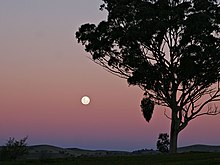Haze


Haze is an atmospheric phenomenon where dust, smoke and other pollutant particles obscure the normal clarity of the sky. It occurs when dust and smoke particles accumulate in relatively dry air. When weather conditions block the dispersal of smoke and other pollutants they concentrate and form a usually low-hanging shroud that impairs visibility and may become a respiratory health threat. Dense haze caused by industrial pollution is also known as smog.
Sources for haze particles include farming (ploughing in dry weather), traffic, industry, forest fires and peat field fire.
Seen from afar (e.g. approaching airplane), haze is brownish, while mist is more blueish-grey. While haze is formed in relatively dryish air, in more humid air mist is formed, and the haze particles can even act as condensation nucleii for the mist droplets.
Haze in Southeast Asia
Haze is a regular problem in Southeast Asia caused by land and forest fires in Indonesia, especially Sumatra and Kalimantan. Those fires mainly affect Brunei, Indonesia, Philippines, Malaysia, Singapore and Thailand. The economic losses of the fires in 1997 have been estimated at US$9.3 billion [1]. This includes damages in agriculture production, destruction of forest lands, health, transportation, tourism, and other economic endeavours. Not included are social, environmental, and psychological problems and long term health effects. The latest bout of haze to occur in Malaysia and the Malacca Straits was in July 2006.
As a reaction, Association of Southeast Asian Nations (ASEAN) signed Agreement on Transboundary Haze Pollution, formed a Regional Haze Action Plan (RHAP) and established a co-ordination and support unit (CSU). As part of this Action Plan and with the help of Canada, a monitoring and warning system for forest/vegetation fires was developed and implemented called Fire Danger Rating System (FDRS). Since September 2003 daily ratings have been issued by the Malaysian Meteorological Service (MMS).[2]
Pollution index

The severity of haze is often measured using automated optical instruments such as Nephelometers, as haze is associated with visibility and traffic control in ports. Haze however can also be an indication of poor air quality though this is often better reflected using accurate purpose built air indexes such as the American Air Quality Index or the Malaysian API (Air Pollution Index).
In hazy conditions, it is likely that the index will report the suspended particulate level. The disclosure of the responsible pollutant is mandated in some jurisdictions.
The American AQI is divided into six color coded categories. Technically AQI runs only from 0 to 500. The 301 to 500 range is categorised as hazardous and colored maroon. [3]
The Malaysian APIs most hazardous category is above 500. Above 500, a state of emergency is declared in the reporting area. Usually, this means that non essential government services are suspended, and all ports in the affected area closed. There may also be a prohibition on private sector commercial and industrial activities in the reporting area excluding the food sector. So far, the state of emergency ruling due to a hazardous API level applied to the Malaysian towns of Port Klang, Kuala Selangor (2005) and Sarawak state (1997).
